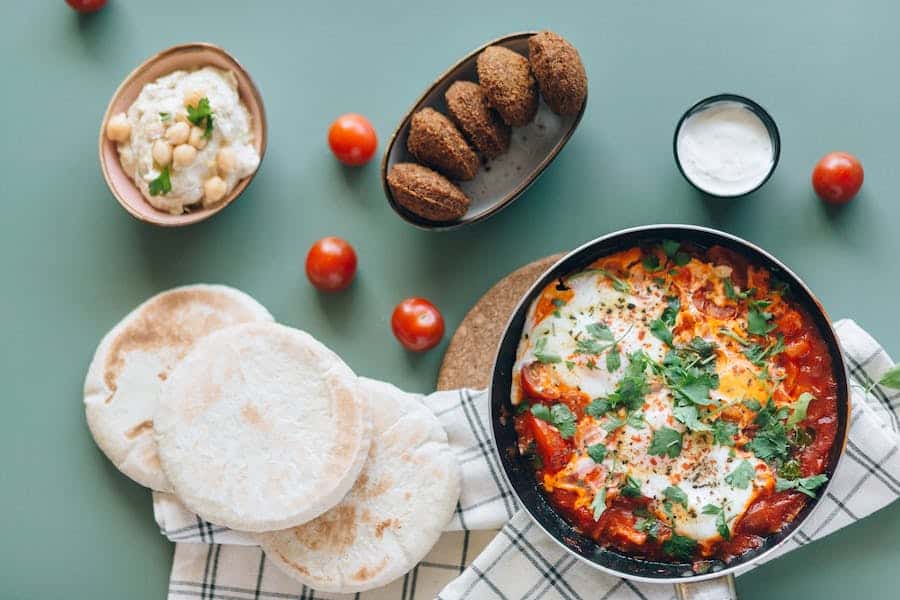Hummus, a beloved Middle Eastern delicacy, has found its way into countless kitchens around the world. Creamy, savory, and incredibly versatile, this chickpea-based spread has won the hearts and palates of food enthusiasts everywhere. In this article, we will embark on a culinary journey to explore the question, “What do you eat hummus with?” From traditional pairings like pita bread and vegetables to creative and unexpected combinations, we’ll uncover the delightful world of hummus and its endless possibilities. Whether you’re a hummus aficionado or a newcomer to this delectable treat, prepare to be inspired and discover new ways to enjoy hummus beyond your expectations.
What Do You Eat Hummus With?
Hummus pairs deliciously with pita bread, vegetables (like cucumbers and carrots), falafel, shawarma, and other Mediterranean dishes. However, its versatility extends to creative pairings such as chips, sandwiches, pizza, sushi, and even as a cooking ingredient. It’s a nutritious, flavorful addition to many meals and snacks.
Traditional Pairings For Hummus
Traditional pairings for hummus are deeply rooted in Middle Eastern and Mediterranean cuisine, where this creamy dip originated. These pairings not only enhance the flavor of hummus but also provide a balanced and satisfying eating experience.
Firstly, pita bread is perhaps the most iconic companion to hummus. Soft, warm pita bread serves as a perfect vessel for scooping up the creamy goodness of hummus. It’s traditionally torn into pieces, creating bite-sized portions that make dipping and savoring hummus a delightful experience. You can find various types of pita bread, from classic white to whole wheat or even gluten-free options, catering to different preferences and dietary needs.
Secondly, an assortment of fresh vegetables is another classic choice for enjoying hummus. Crisp and colorful vegetables like cucumbers, bell peppers, carrots, and cherry tomatoes complement the creamy texture of hummus. They provide a refreshing contrast and add a healthy crunch to each bite. Dipping these veggies into hummus not only enhances the flavor but also elevates the nutritional value of your snack or appetizer.
Thirdly, falafel and hummus go hand in hand in Middle Eastern cuisine. Hummus serves as an excellent sauce or dip for falafel, which are deep-fried balls or patties made from ground chickpeas or fava beans. The creaminess of the hummus balances the spiciness of falafel, creating a harmonious flavor combination that’s enjoyed in wraps, sandwiches, or as a stand-alone dish.
Lastly, hummus pairs beautifully with shawarma, a popular Middle Eastern street food. Shawarma is typically made with thinly sliced, seasoned meat (such as chicken, beef, or lamb), and the flavors of the meat blend seamlessly with the creamy hummus. This pairing is often served in pita bread or flatbreads, creating a delightful fusion of textures and flavors that leaves taste buds craving for more.
Why Hummus Works Well In Mediterranean Meals?
Hummus works exceptionally well in Mediterranean meals for several compelling reasons:
- Shared Origins: Hummus hails from the Middle East, specifically the Levant region, which includes countries like Lebanon, Israel, and Syria. This geographical proximity makes it a natural fit in Mediterranean cuisine, which encompasses a wide range of dishes from the Mediterranean basin.
- Healthy And Balanced: Mediterranean cuisine is renowned for its health benefits, primarily due to its emphasis on fresh and wholesome ingredients. Hummus aligns perfectly with this ethos, as it is made from nutrient-rich chickpeas, olive oil, tahini, and various seasonings. It adds a dose of plant-based protein, fiber, and healthy fats to Mediterranean meals, contributing to their overall nutritional balance.
- Versatility: Hummus’s versatility allows it to complement a wide array of Mediterranean dishes. Whether served as a dip for pita bread or a side with grilled vegetables, hummus’s creamy texture and subtle flavors enhance the overall dining experience. It can even be incorporated into salad dressings or used as a marinade for meats, further extending its adaptability in Mediterranean cuisine.
- Texture And Flavor Harmony: The creamy and slightly nutty taste of hummus pairs harmoniously with the textures and flavors prevalent in Mediterranean cuisine. It complements the crispy, fresh vegetables, tender grilled meats, and earthy herbs commonly featured in these dishes, adding a rich and satisfying dimension to each bite.
- Cultural Significance: Hummus holds cultural significance in many Mediterranean countries. It is often considered a symbol of hospitality and togetherness, making it a staple at gatherings, celebrations, and family meals. Its presence in Mediterranean cuisine reinforces its cultural relevance and enduring popularity in the region.
- Adaptability To Local Variations: While hummus has its traditional recipe, it can also be adapted to suit regional preferences within the Mediterranean. For example, variations like roasted red pepper hummus, olive hummus, or even spicy hummus can be found in different Mediterranean countries, offering a local twist on this beloved dish.
Nutritional Benefits Of Hummus
Hummus offers a range of nutritional benefits, making it a healthy addition to your diet. Here are some of the key nutritional benefits of hummus:
- Protein Content: Hummus is a good source of plant-based protein, primarily derived from chickpeas. This makes it an excellent option for vegetarians and vegans looking to meet their protein needs. Protein is essential for muscle repair, immune function, and overall body maintenance.
- Fiber And Complex Carbohydrates: Chickpeas, the primary ingredient in hummus, are rich in dietary fiber and complex carbohydrates. Fiber aids in digestion helps regulate blood sugar levels, and promotes a feeling of fullness, which can be beneficial for weight management.
- Healthy Fats: Hummus typically includes olive oil, which is a source of healthy monounsaturated fats. These fats are heart-healthy and may help reduce the risk of cardiovascular disease when consumed in moderation.
- Micronutrients: Hummus contains various vitamins and minerals, including folate, vitamin B6, iron, magnesium, and zinc. These micronutrients play essential roles in various bodily functions, such as energy metabolism, immune support, and oxygen transport in the blood.
- Antioxidants: Ingredients like chickpeas and tahini in hummus provide antioxidants, which help protect cells from oxidative stress and reduce the risk of chronic diseases.
Tips For Perfect Hummus
Creating perfect hummus requires attention to detail and a few key techniques. Here are some tips to help you achieve a creamy and flavorful hummus:
Use High-Quality Ingredients:
Start with fresh, high-quality ingredients, especially chickpeas and tahini. Freshly cooked or canned chickpeas work well, and make sure your tahini is well-blended.
Cook Chickpeas Thoroughly:
If you’re using dried chickpeas, cook them until they are very tender. Overcooked chickpeas are easier to blend into a creamy consistency.
Remove Chickpea Skins:
For an even smoother texture, consider removing the skins from the chickpeas after cooking. This step can be a bit time-consuming but results in a creamier hummus.
Balance The Ingredients:
Adjust the ingredients to achieve the right balance. Taste and adjust the quantities of lemon juice, garlic, tahini, and olive oil to suit your preferences.
Use Ice Water:
To achieve a light and airy texture, add ice water gradually while blending. Cold water helps emulsify the ingredients and creates a smoother consistency.
Blend Thoroughly:
Blend the hummus for an extended period to ensure a silky-smooth texture. This may take a few minutes. If your blender or food processor has a high-speed setting, use it.
Season Well:
Season your hummus generously with salt, and consider adding a pinch of cumin or paprika for depth of flavor. Taste as you go to find the perfect balance.
Conclusion
In conclusion, perfecting hummus is a culinary art that involves using quality ingredients, precise techniques, and a keen palate. By balancing flavors, achieving a creamy texture, and experimenting with variations, you can create a hummus that suits your taste preferences. Whether enjoyed as a dip, spread, or part of a larger meal, the satisfaction of creating and savoring your ideal hummus is a rewarding culinary journey worth embarking on.
FAQ’s
Is Hummus Gluten-Free?
Yes, hummus is naturally gluten-free since it is primarily made from chickpeas, tahini, lemon juice, and spices. However, it’s essential to check labels for additives or cross-contamination if you have gluten sensitivity or celiac disease.
How Long Can I Store Homemade Hummus?
Homemade hummus can be stored in an airtight container in the refrigerator for up to 3-5 days. Be sure to refrigerate it promptly after use.
Can I Freeze Hummus?
Yes, you can freeze hummus. Portion it into airtight containers, leaving some room for expansion, and freeze for up to 2-3 months. Thaw in the refrigerator and stir before serving.
Is Hummus A Good Source Of Protein?
Yes, hummus is a decent source of plant-based protein, primarily from chickpeas. It’s an excellent option for vegetarians and vegans to incorporate into their diets.
Can I Use Canned Chickpeas For Hummus?
Yes, canned chickpeas work well for making hummus. Just be sure to rinse and drain them thoroughly before use to remove excess salt and improve the hummus’s texture.








